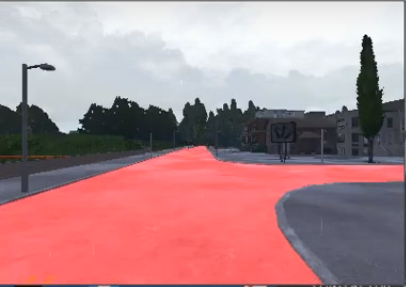

Status : Ongoing
Tags: Autonomous vehicle Path-Planning Carla Road Detection

To design a fully functional Autonomous Self Driving Car in CARLA Simulator
Carla
DWA
Machine-learning
Semantic-Segmentation
yolov4
Introduction to Carla
CARLA has been developed from the ground up to support development, training, and validation of autonomous driving systems. In addition to open-source code and protocols, CARLA provides open digital assets (urban layouts, buildings, vehicles) that were created for this purpose and can be used freely. The simulation platform supports flexible specification of sensor suites, environmental conditions, full control of all static and dynamic actors, map generation and much more.
Road-Detection
Lane-Detection
To implement Lane-Detection we used opencv-canny edge detection over the result of our Road-detection part. Then to draw lanes from image to our real-world we use the feed of depth-camera mounted at the same location of our rgb-camera.
# Compute x and y coordinates
for i in range(H):
for j in range(W):
X[i, j] = ((j+1 - self.c_u)*depth[i, j]) / self.f
Demo Video (https://www.youtube.com/watch?v=4d8uz27Agvs)
Object-Detection
Model used : yolov4
Full Report : (https://roboticsclub.mnnit.ac.in/projects/detail/8/)
Path-Planning (DWA)
Dynamic Window Approach(DWA) is a local path-planning algorithm. It does not know about the global path. We used to give the positions of the goal, objects and lines. Then it computes the most favoured path.
STEPS:
# Dynamic window from robot specification
Vs = [self._config.min_speed, self._config.max_speed, -self._config.max_yaw_rate, self._config.max_yaw_rate]
# Dynamic window from motion model
Vd = [state[3] - self._config.max_accel * self._config.dt, state[3] + self._config.max_accel * self._config.dt, state[4] - self._config.max_delta_yaw_rate * self._config.dt, state[4] + self._config.max_delta_yaw_rate * self._config.dt]
dw = [max(Vs[0], Vd[0]), min(Vs[1], Vd[1]), max(Vs[2], Vd[2]), min(Vs[3], Vd[3])]
def _predict_trajectory(self, x_init, v, y):
x = np.array(x_init)
trajectory = np.array(x)
time = 0
while time <= self._config.predict_time:
x = self.motion(x, [v, y], self._config.dt)
trajectory = np.vstack((trajectory, x))
time += self._config.dt
return trajectory
for v in np.arange(dw[0], dw[1], self._config.v_resolution):
for y in np.arange(dw[2], dw[3], self._config.yaw_rate_resolution):
trajectory = self._predict_trajectory(x_init, v, y)
There are 4 types of cost.
to_goal_cost = goal_cost_gain * calc_to_goal_cost(trajectory)
speed_cost = speed_cost_gain * (self._config.max_speed -
trajectory[-1, 3])
ob_cost = obstacle_cost_gain * calc_obstacle_cost(trajectory,
x_init)
lane_cost = lane_cost_gain * calc_lane_cost(trajectory, x_init)
final_cost = to_goal_cost + speed_cost + ob_cost + lane_cost
if min_cost > final_cost :
min_cost = final_cost
best_u = [v, y]
best_trajectory = trajectory
Future Work
Conclusion
YouTube (Playlist):
https://youtube.com/playlist?list=PLvF-o_Kkrx182f--pGoFnpKpGXctXnowy